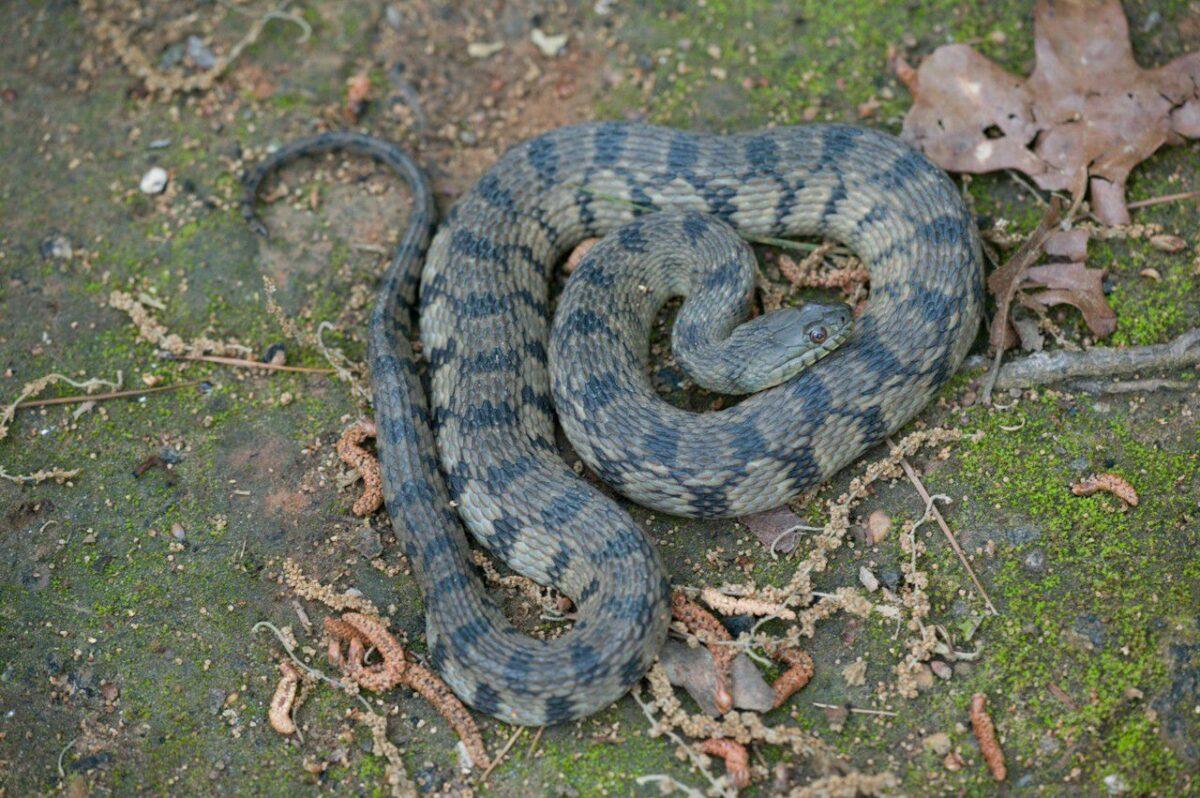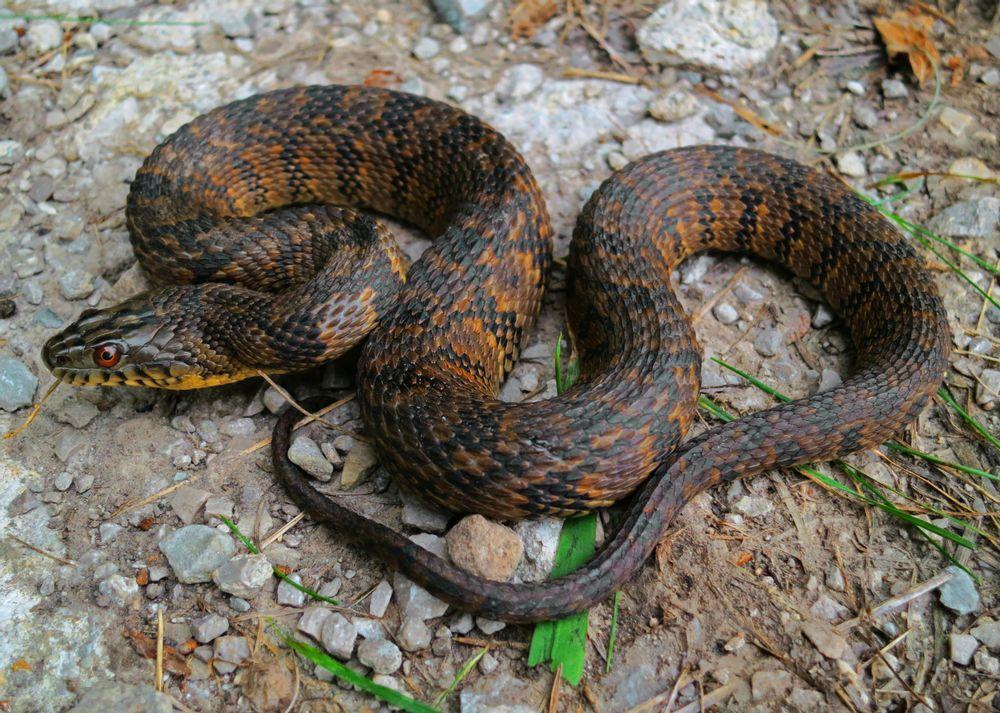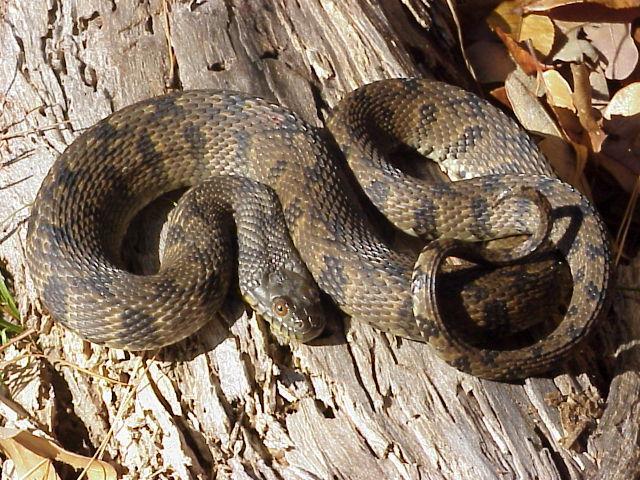Have you ever been near a body of water, maybe a creek or a pond, and caught a glimpse of something long and dark moving through the shallows? It could have been a diamondback water snake, a truly fascinating creature that, as a matter of fact, calls many of our watery spots home. This particular snake holds the title of being the biggest water snake found across North America, so you might just be seeing a sizable serpent.
Now, it's a common thing for folks to feel a little jumpy around snakes, and sometimes, a creature like the diamondback water snake gets a bad rap because of how it looks. But here's the thing, it's a nonvenomous animal, meaning it doesn't have venom that could hurt a person. Its scientific name is *Nerodia rhombifer*, and it's a type of colubrid, which is just a fancy way of saying it belongs to a very large family of snakes, many of which are completely harmless to us.
This snake, you see, makes its living mostly in the central parts of the United States and stretches down into northern Mexico. It's a native resident, perfectly at home in the rivers, lakes, and marshes of these areas. Its unique appearance, with those striking markings, often leads to a bit of confusion, but once you get to know a little about it, you'll find there's really nothing to worry about.
Table of Contents
- What Makes the Diamondback Water Snake Stand Out?
- Where Do You Find the Diamondback Water Snake?
- Is the Diamondback Water Snake Dangerous?
- A Glimpse into the History of the Diamondback Water Snake
- What Challenges Face the Diamondback Water Snake?
- Common Misconceptions About the Diamondback Water Snake
- Living Alongside the Diamondback Water Snake
What Makes the Diamondback Water Snake Stand Out?
When you see a diamondback water snake, there's a good chance you'll notice it right away because of its rather distinct markings. It has a pattern that, you know, really catches the eye. These snakes are, in a way, like living works of art, with their unique skin designs. They tend to have these dark, somewhat diamond-shaped blotches that run along their backs. These blotches are then connected by other dark bars that alternate, making a truly intricate design all over their bodies. This pattern, actually, is where they get their common name from, as it sort of reminds people of the shape of diamonds. It's a striking look, for sure, and it helps them blend into their watery surroundings, too.
The Unique Look of the Diamondback Water Snake
The skin of a diamondback water snake is pretty special, honestly. Imagine a series of dark, almost squarish marks that line up down its back. Then, picture these marks being joined up by other dark lines that go back and forth, making a sort of net-like appearance. This is what gives the snake its famous "diamondback" look. The colors can vary a bit, but typically, they have a brownish or grayish base color with these darker patterns overlaid. It's a pattern that, in some respects, serves a good purpose, helping them to disappear into the murky waters and tangled plant life where they often live. So, it's not just for show; it's a way for them to stay hidden from things that might want to eat them, and also from the little fish and frogs they like to eat.
The texture of their skin is also something to consider. Like many snakes, they have scales, but the way these scales catch the light, especially when they're wet, can make their patterns seem even more pronounced. It’s a pretty effective natural camouflage, allowing them to wait patiently for their next meal or to avoid being seen by larger creatures. You know, it’s a truly clever design from nature, helping them survive in their watery homes. They really do look quite impressive, particularly when they are stretched out in the sun on a rock or a log, warming up after a swim.
How Big Can a Diamondback Water Snake Get?
When we talk about the size of the diamondback water snake, we're really talking about a big snake. It's the largest of all the water snakes found in North America, which is a pretty impressive title to hold. They can get to be a decent length, sometimes reaching lengths that might surprise you. While exact sizes can vary depending on where they live and how much food they get, they are definitely among the longer snakes you might come across in their natural areas. A full-grown adult can, quite literally, be a couple of feet long, or even more, making them a noticeable presence in their watery world.
Their girth, or how thick they are, also adds to their imposing size. They aren't just long; they can be fairly stout, too. This size helps them, of course, in catching their food, which often includes fish and amphibians that might be a good meal for a snake of their proportions. It also means they can be mistaken for something more threatening, just because of their sheer size. But even with their considerable length and thickness, they are still, you know, generally quite timid creatures that prefer to keep to themselves. They're built for their aquatic lifestyle, and their size is just one part of what makes them so well-suited to it.
Where Do You Find the Diamondback Water Snake?
If you're wondering where you might actually bump into a diamondback water snake, you'd typically look in the central parts of the United States. They have a particular preference for certain types of places, generally those with plenty of water. Their range extends quite a bit, stretching from the central states down into the northern areas of Mexico. So, if you live in places like Texas, Oklahoma, Kansas, Missouri, or even parts of Illinois and Indiana, you're pretty much in their home territory. They are, essentially, a part of the natural wildlife in these regions, adapted perfectly to the local conditions.
Home Turf of the Diamondback Water Snake
The diamondback water snake really loves its watery homes. You'll find them hanging out in all sorts of places where there's fresh water, like slow-moving rivers, calm lakes, ponds, and even swamps and marshes. They are, in a way, always close to water, as it's where they find their food and feel most comfortable. They're pretty good swimmers, too, and can often be seen gliding gracefully through the water or basking on rocks and logs near the water's edge. They tend to stick to areas where there's plenty of cover, like thick vegetation or submerged branches, which helps them hide from things that might want to harm them, or, you know, from the prey they're hoping to catch. It's their natural habitat, and they are perfectly suited to living in these damp environments.
Their distribution is pretty much tied to these specific water sources. They don't typically stray too far from a reliable water body, as their whole way of life depends on it. So, if you're out exploring nature in their native range, and you come across a calm stream or a quiet pond, there's a good chance a diamondback water snake might be somewhere nearby, just going about its day. They are, after all, a truly integral part of these aquatic ecosystems, playing their part in the natural balance of things. They're a common sight in these areas, and honestly, they're quite interesting to watch from a respectful distance.
Is the Diamondback Water Snake Dangerous?
This is a question that pops up a lot, and it's a really important one to address. Many people see a snake, especially a larger one, and their first thought is often about danger. However, when it comes to the diamondback water snake, the answer is pretty straightforward: no, it's not dangerous in the way many people fear. It is, to be honest, a nonvenomous snake. This means it doesn't produce venom, and it can't inject any harmful substances into you if it bites. So, you don't have to worry about a venomous bite from this particular creature. Any fear you might have about it being a threat, you know, from venom, is simply not based on fact.
Understanding the Diamondback Water Snake's Temperament
While the diamondback water snake isn't venomous, it can still, like any wild animal, defend itself if it feels threatened. If you get too close or try to pick it up, it might try to bite. These bites, however, are not dangerous; they're more like a scratch, and while they might draw a little blood, they're not going to cause serious harm. They are, in a way, just trying to tell you to leave them alone. Their main defense is usually to try and get away, slipping into the water and swimming off. They are, you know, generally quite shy creatures that prefer to avoid contact with people. They're not looking for trouble, really.
The confusion about whether they are dangerous often comes from their appearance. Their patterns can, to some people, look similar to those of certain venomous snakes. Plus, when they feel cornered, they might flatten their heads, which can make them look a bit more menacing. But this is just a bluff, a way of trying to scare off whatever is bothering them. It's really just a survival instinct, basically. So, the best thing to do if you see a diamondback water snake is to give it some space and let it go about its business. They are, after all, just trying to live their lives, and they pose no real threat to people who respect their space.
A Glimpse into the History of the Diamondback Water Snake
Every animal has its own story, and for the diamondback water snake, part of that story involves how it first came to be known and formally identified by humans. It's not like these snakes just appeared; they've been around for a very long time. But the process of giving them a scientific name and describing them for the record is a relatively more recent chapter. This act of naming helps scientists and enthusiasts alike to better categorize and, you know, talk about the different kinds of animals we share the planet with. It's a way of bringing order to the natural world, in a sense.
The First Description of the Diamondback Water Snake
The diamondback water snake was first officially described way back in 1852. The person who did this was a fellow named Edward Hallowell. He was, as a matter of fact, a naturalist and a physician, and he played a part in documenting many species during his time. He gave this snake the scientific name *Tropidonotus rhombifer*. Now, that's a mouthful, and over time, the scientific name changed a bit to what we know today as *Nerodia rhombifer*. But it was Hallowell who first put it on the map, so to speak, giving it its first formal recognition in the scientific community. This early description was a key step in understanding this particular snake and its place in the animal kingdom. It's a bit like its birth certificate, really, in the world of science.
That initial naming was pretty important because it helped other naturalists and scientists to recognize and study the species more effectively. It provided a common reference point for everyone interested in snakes. So, while the name itself might have shifted a little over the years, the core discovery by Edward Hallowell remains a significant moment in the history of understanding the diamondback water snake. It shows how, you know, our knowledge of the natural world builds up over time, piece by piece, thanks to the work of people like him who took the time to observe and document what they saw.
What Challenges Face the Diamondback Water Snake?
Even though the diamondback water snake is often described as a "tough cookie," meaning it's pretty resilient and can handle a lot, it's not entirely free from problems. Just like many other wild animals, it faces some serious issues that can make life a bit harder for it. These are things that, you know, are happening in its watery home and beyond, which can really impact its well-being and numbers. It's a reminder that even creatures that seem strong and adaptable can still be vulnerable to changes in their environment and how people interact with them. So, it's not all smooth sailing for these snakes, unfortunately.
Keeping the Diamondback Water Snake Safe
One of the biggest challenges for the diamondback water snake, and many other animals, is the loss of their natural living spaces. As human populations grow and we build more, the wetlands, rivers, and ponds that these snakes call home can sometimes disappear or get changed. This means less room for them to live, hunt, and reproduce. Another issue is water pollution, which can harm the fish and frogs they eat, and directly affect the snakes themselves. They are, after all, very connected to the health of their water sources. Also, sadly, sometimes people mistake them for dangerous snakes and harm them, even though they are nonvenomous. This is, you know, a pretty sad consequence of misunderstanding. Protecting their habitats and educating people about them are key steps to keeping the diamondback water snake population healthy and thriving. It's really about giving them the space and clean environment they need to just be snakes.
Their ability to survive despite these challenges speaks to their natural hardiness, but that doesn't mean they don't need our consideration. Things like litter in waterways, or the general disturbance of their basking spots, can also cause them stress. It's a continuous balancing act for them, trying to find food and shelter while also avoiding potential threats, both natural and human-made. So, when we think about how to keep the diamondback water snake around for a long time, it really comes down to looking after their homes and helping people understand that these snakes are, in fact, a valuable part of our natural world, not something to fear or harm.
Common Misconceptions About the Diamondback Water Snake
It's pretty common for people to have some mixed-up ideas about snakes, and the diamondback water snake is no exception. Because of how it looks and where it lives, it often gets confused with other snakes, some of which are indeed dangerous. This confusion, you know, can lead to unnecessary fear and sometimes even harm to the snake. It's a shame, really, because if people knew more about this particular snake, they'd realize it's truly nothing to be afraid of. It’s a classic case of mistaken identity, basically, which happens quite a lot in the animal kingdom.
Why the Diamondback Water Snake is Often Misunderstood
The main reason the diamondback water snake is
Related Resources:



Detail Author:
- Name : Kenya Macejkovic
- Username : brionna.erdman
- Email : boehm.adella@gmail.com
- Birthdate : 1974-08-14
- Address : 2437 Garth Rapids Apt. 401 Cormierberg, ND 97488
- Phone : 1-283-901-1478
- Company : Corkery Inc
- Job : Painter
- Bio : Quisquam animi est nisi eum nemo mollitia. Delectus quia voluptatem animi corrupti perferendis sit quis et. Pariatur atque ex incidunt ut voluptas id.
Socials
twitter:
- url : https://twitter.com/o'konk
- username : o'konk
- bio : Rerum odio sint distinctio et est. Deserunt quibusdam odit libero et. Optio autem impedit odio vel deleniti.
- followers : 1004
- following : 615
linkedin:
- url : https://linkedin.com/in/kali_o'kon
- username : kali_o'kon
- bio : Alias corrupti voluptas eius maxime.
- followers : 4757
- following : 66
instagram:
- url : https://instagram.com/kalio'kon
- username : kalio'kon
- bio : Vero consequuntur ullam quia. Enim ea praesentium enim dolorum.
- followers : 4986
- following : 2842
facebook:
- url : https://facebook.com/kali9726
- username : kali9726
- bio : Iusto nihil est ea ut debitis. Dolores cupiditate odit vero libero porro.
- followers : 831
- following : 795
tiktok:
- url : https://tiktok.com/@o'kon2011
- username : o'kon2011
- bio : Est ut ut amet non tenetur nemo non.
- followers : 3762
- following : 521